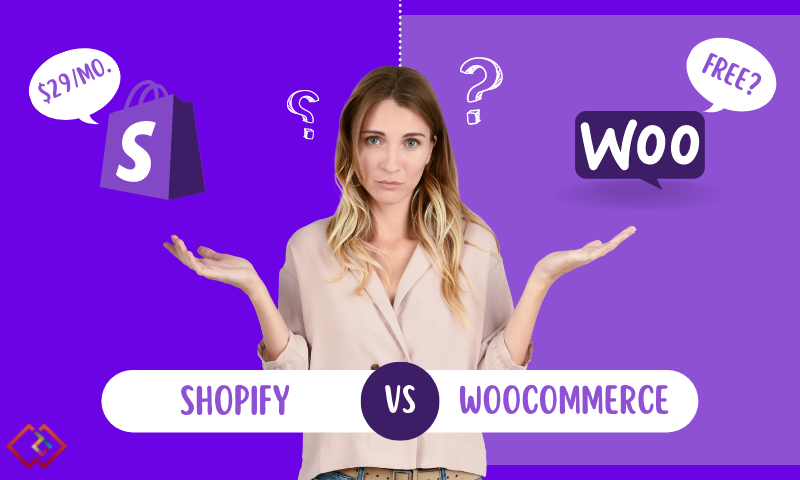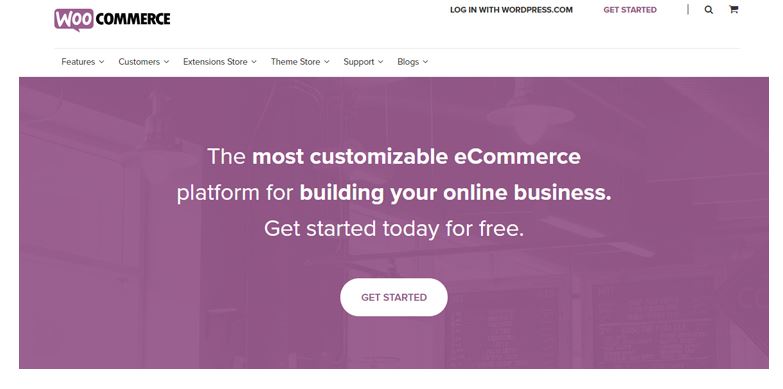Wondering which is the platform of choice for your D2C or Dropshipping Ecommerce store? – Here is the in-depth comparison for Shopify Vs WooCommerce.
If you own an online business, you are probably already aware that selecting an eCommerce platform is the very first step in creating an online store. As a result, you’re probably wondering, “Shopify Vs WooCommerce: Which one should I choose?”

WooCommerce and Shopify are two of the most widely used eCommerce platforms in the world, and online store owners frequently struggle with which one to pick between two.
The Freedom Customize?
The Shopify platform is exclusive. There are few product variations, no subcategories, and no migration possibilities, and you have no recourse. You will have to depend on some developers to make changes that are not pre-built by Shopify plugins, most of which do not come for free.
The freedom of open source is only available with WooCommerce. With complete control, you may integrate any service, alter any feature of your site, and own the entire source code.
Here is a brief table of contents for this in-depth comparison of Shopify and WooCommerce:
- Cost evaluation
- Comparison of ease of usage
- Payment procedures
- Comparing drop shipping
- Which is superior between WooCommerce and Shopify, in the end?
WooCommerce Vs Shopify: An Overview
It’s crucial to discuss the fundamentals and emphasize what makes these platforms unique before we begin our detailed comparison of the two most used eCommerce platforms on the internet.
What is Shopify.?

You can create an online store, collect payments, and manage your inventory all from a single platform with Shopify, an all-in-one eCommerce solution.
With Shopify, you can manage an eCommerce site without having to deal with technical issues, such as web hosting, security, caching, etc.
What is WooCommerce?
WooCommerce is thus not a true e-commerce platform. It is a free, open-source plugin that transforms your WordPress website into an effective online store. Your store will be operational as soon as you install the WooCommerce plugin on your WordPress website.
Open-source eCommerce plugin for WordPress called WooCommerce. You can use the most powerful content management system (CMS) to operate an online business thanks to this plugin.

WooCommerce is the most popular eCommerce platform, yet many people are unaware that WordPress is the most popular website builder on the planet, powering 43% of all websites. WooCommerce is open-source, so you can add custom extensions and change any business element.
What Features should your eCommerce Platform Have?
When opening an internet store, there are a few things that you must never forget. You can choose which platform is most appropriate for your needs using these important criteria.
Budget – The starting price for a fully operational online store.
Usefulness – It ought to be simple to use, especially for beginners.
Payment Options – It should enable various payment options (e.g. PayPal, Stripe, and other merchant processors).
You can integrate several third-party services and solutions to expand your eCommerce business.
Scalability – The platform must be able to grow with your company.
These are the bare minimum requirements that every proprietor of an online store should consider.
Yet, you could also want to consider other alternatives, such as shipping, inventory control, invoicing, taxes, drop shipping, etc., depending on your needs.

Cost Comparison – Shopify vs WooCommerce
Cost is the most crucial factor for proprietors of eCommerce websites.
You must assess the startup costs while also taking into account the varying costs for more services and software.
The Actual Cost of Shopify Use Creating an online store using Shopify is quite simple.
Their entry-level package costs $29 a month and an upgrade to the Shopify plan costs $79 or $299 per month for the Advanced Shopify plan.
Another element that affects your expenditures is payments. Shopify has its own Shopify Payments service, with a base price of 2.9% + 30 cents for each transaction.
You will be charged a fee of 2.0% for all transactions if you use third-party payment gateways or your merchant account. By purchasing the Shopify Advanced plan, which costs $299 per month, you may lower this price to 0.5%.
When using external payment gateways, these processing fees are pretty high. However, the Shopify Payments solution’s prices are somewhat equal to those of well-known services like Stripe and Braintree.
Shopify also has a $9.00/month option called Shopify lite. With this package, you can use Shopify to make in-person sales in some areas or add buy buttons to any website.
Shopify Vs WooCommerce – Ease of Use
Most business owners starting an online store are neither web developers nor designers. Even people who are aware of the fundamentals must have a platform that is simple to use and stays out of the way.
Let’s examine the user-friendliness of Shopify vs WooCommerce.
Shopify aces the store setup simply because Shopify is a completely hosted platform; you won’t need to install, manage or update any software. You don’t have to worry about performance, backups, security, or compatibility problems. You can start with the Shopify ecommerce store without needing any developers at the beginning unless you have custom theme design requirements.
You can select a design from various free Shopify themes as soon as you join up. The self-guiding Shopify onboarding lets you add products and the rest of the ecommerce customization. Many plugins, both free and premium, are available that can in simplified e-commerce automation. You can select a design from various free Shopify themes as soon as you join. Then they help you add products after guiding you through customization.
WooCommerce offers tremendous customization flexibility. The entire platform is under your control. With more than 59,000 WordPress plugins, you can add any functionality to your website. Many of these WordPress plugins are free or at least free to try, which greatly boost Woocommerce’s usability.
There was no drag-n-drop page builder before, but with Gutenberg page builder that now comes default with WordPress has added flexibility. However, to ace the design and functionality game you might have to depend on paid WordPress page builders like Elementor or Beaver Builder or Seedpod.
WooCommerce’s major drawback is that it has a learning curve and necessitates more active website management. If you’re entirely new to WordPress, you might even need developer assistance simply installing WordPress. Additionally, you must register for a merchant account for Payment Gateways, SMS Automation Gateways, and more. You have to handle the traffic and security requirement and may even need a robust VPS to build a comparable front-end and back-end performance similar to Shopify.
Even if the WooCommerce-assisted setup wizard is helpful, Shopify’s onboarding process and simplicity of use much outweigh its own.
Unlike Shopify, WooCommerce is not a hosted platform. This calls for the installation of the WooCommerce plugin, management of updates, preservation of backups, and assurance of the safety of your website.
So in the usability comparison of Shopify Vs Ecommerce, Shopify wins for smaller and newer stores with easy onboarding and maintenance, whereas WooCommerce is more flexible and cost-effective in the long run.
Payment Options: Shopify Vs WooCommerce
You can accept payments online using a variety of payment gateways. Some payment options might not be appropriate for you, and your clients might not have access to others.
Shopify Payment Options
Customers can use a variety of payment methods on Shopify when checking out. Along with all the well-known third-party payment channels, it has its own payment system called Shopify Payments (powered by Stripe).
Credit card costs are charged through Shopify Payments, but no other transaction fees apply. For the basic plan, credit card rates start at 2.9% + 30 and decrease for after plans.
Shopify also supports many of the well-known payment gateways specific to countries as well as global partners such as Paypal, PayU, Razorpay etc.. Installing payment connectors for Allow.net, Amazon Pay, Square, Alipay, and many other services is possible with Shopify payment plugins.
Options for Payment in WooCommerce
WooCommerce, by default, accepts payments through Stripe and PayPal. They also have a Stripe-powered WooCommerce Payments solution. Being an open-source e-commerce D2C platform, it lets you integrate virtually any third-party Payment gateway like CCAvenue, PayU, BillDesk or Razorpay.
As discussed earlier, you must register and maintain an account with your Payment gateway provider before integrating with the WooCommerce platform.
Dropshipping – Shopify vs WooCommerce
What is Dropshipping Business Model for Ecommerce?
Dropshipping is an online business model where an eCommerce retailer doesn’t keep the products on hand. Instead, it buys goods from suppliers and ships them to clients to fulfill orders.
The front end of your website while developing a drop shipping business will resemble any other online store. Like any e-commerce store, your consumers can browse products, add them to carts, and make purchases.The user’s order for shipping will then need to be placed, depending on the suppliers you select.
The platform of choice for dropshipping companies is WooCommerce. The adaptable dropshipping plugins for WooCommerce make the entire setup procedure quite simple.
Extensions enabling you to import products immediately, process orders from your website, and more are easy to find. You might even build an online store like eBay where other merchants could sell their products.
Shopify offers integration tools for well-known drop shipping marketplaces, including AliExpress, Oberlo, Printify, and others. Shopify is the market leader in the segment, and many people discover Shopify because they want to start Dropshipping and its ease of use when it comes to getting started.
So choose your weapon wisely, especially considering the scale and knowledge you’re starting the dropshipping business with.
The Verdict – WooCommerce and Shopify?
Both Shopify and WooCommerce are effective platforms for launching your online store. It depends on your unique preferences and skill set.
For someone who never indulged in website development and management, Shopify is the best choice for the price you pay. You don’t need to install or need external support from developers or designers to start selling your products. The payment options, SMS, email marketing, and everything is seamlessly integrated within Shopify.
WordPress is the answer if you have even little experience managing a WordPress website or have the knack to learn or DIY. Thanks to WooCommerce, which is open source, you have total control over your website’s design, code, and functionality. Woocommerce is powered by a community of users, thousands of plugins, and themes.
To sum up – WooCommerce is the finest platform for you if you seek an affordable solution and want complete control over your online business. Shopify is an excellent platform if you want something that is hassle-free and offers endless scalability.











